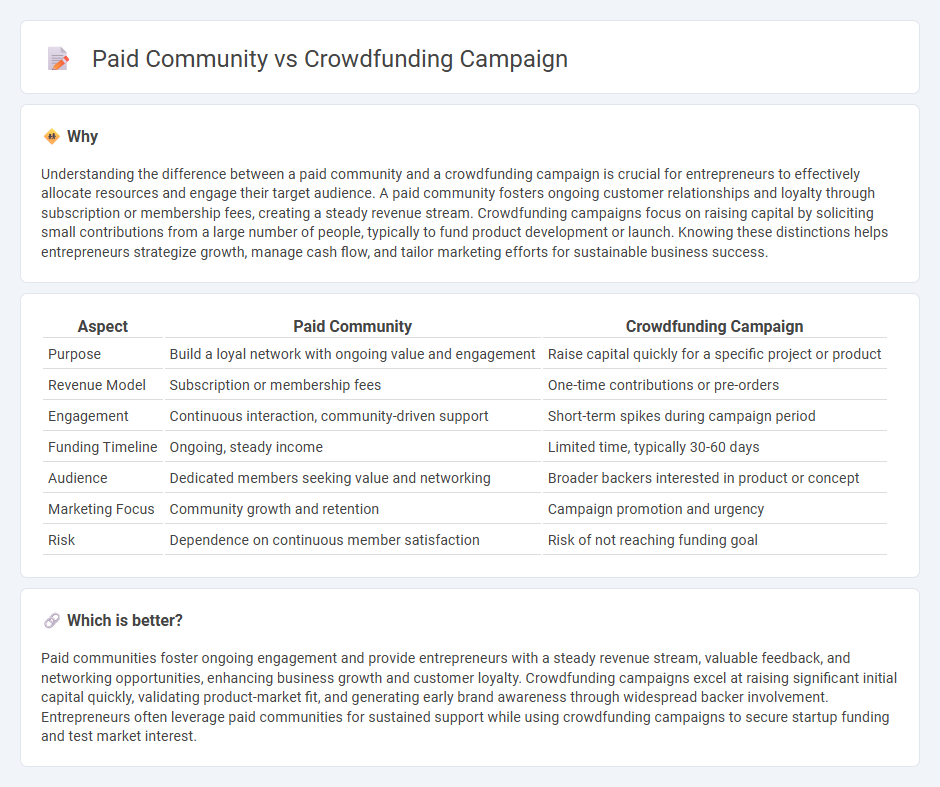
A paid community offers entrepreneurs exclusive access to resources, mentorship, and networking opportunities in exchange for membership fees, fostering long-term engagement and support. Crowdfunding campaigns enable startups to raise capital by appealing directly to a broad audience, leveraging platforms like Kickstarter or Indiegogo for project validation and funding. Discover how each approach can strategically accelerate your entrepreneurial journey.
Why it is important
Understanding the difference between a paid community and a crowdfunding campaign is crucial for entrepreneurs to effectively allocate resources and engage their target audience. A paid community fosters ongoing customer relationships and loyalty through subscription or membership fees, creating a steady revenue stream. Crowdfunding campaigns focus on raising capital by soliciting small contributions from a large number of people, typically to fund product development or launch. Knowing these distinctions helps entrepreneurs strategize growth, manage cash flow, and tailor marketing efforts for sustainable business success.
Comparison Table
| Aspect | Paid Community | Crowdfunding Campaign |
|---|---|---|
| Purpose | Build a loyal network with ongoing value and engagement | Raise capital quickly for a specific project or product |
| Revenue Model | Subscription or membership fees | One-time contributions or pre-orders |
| Engagement | Continuous interaction, community-driven support | Short-term spikes during campaign period |
| Funding Timeline | Ongoing, steady income | Limited time, typically 30-60 days |
| Audience | Dedicated members seeking value and networking | Broader backers interested in product or concept |
| Marketing Focus | Community growth and retention | Campaign promotion and urgency |
| Risk | Dependence on continuous member satisfaction | Risk of not reaching funding goal |
Which is better?
Paid communities foster ongoing engagement and provide entrepreneurs with a steady revenue stream, valuable feedback, and networking opportunities, enhancing business growth and customer loyalty. Crowdfunding campaigns excel at raising significant initial capital quickly, validating product-market fit, and generating early brand awareness through widespread backer involvement. Entrepreneurs often leverage paid communities for sustained support while using crowdfunding campaigns to secure startup funding and test market interest.
Connection
Paid communities empower entrepreneurs by fostering dedicated networks where members share valuable insights and support, enhancing project credibility and engagement. Crowdfunding campaigns benefit from these communities through direct access to motivated backers, increasing funding success rates and early validation. This symbiotic relationship accelerates startup growth by combining financial resources with a loyal, informed customer base.
Key Terms
Crowdfunding campaign:
Crowdfunding campaigns leverage collective funding from a diverse audience to launch projects, validate market demand, and generate early sales, often through platforms like Kickstarter or Indiegogo. They create a sense of urgency and reward-based incentives, driving backer engagement and brand awareness during the campaign period. Explore detailed strategies to maximize crowdfunding success and transform backers into loyal customers.
Backers
Crowdfunding campaigns engage backers by offering early access to products and exclusive rewards, creating a sense of urgency and direct contribution to a project's success. Paid communities attract backers through ongoing value, such as networking opportunities, expert insights, and continuous engagement, fostering long-term loyalty rather than one-time support. Explore how each approach can optimize backer involvement and drive your project's growth.
Funding goal
Crowdfunding campaigns target specific funding goals by leveraging one-time contributions from a broad audience, generating immediate capital for projects or startups. Paid communities build ongoing revenue streams through membership fees, creating sustainable financial support and long-term engagement. Explore the advantages of each model to determine the best strategy for reaching your funding objectives.
Source and External Links
Crowdfunding: An Ultimate Guide for Individuals & Nonprofits - Crowdfunding is a fundraising method collecting small amounts from many people online, with success depending on a clear goal, incentives, strategy, and active promotion, as illustrated by Delta Rae's campaign raising $274,262 on a $30,000 goal through exclusive pledges and fan engagement.
Successful Crowdfunding Campaign Examples - Iconic campaigns like Pebble Time raised over $20 million by leveraging community, early-bird specials, transparent updates, and strong engagement, demonstrating how building and maintaining a loyal backer base is critical for success.
11 Elements of a Successful Crowdfunding Campaign - Key success elements include offering multiple price points to attract diverse backers, consistent promotion through social media and email, and continuous communication to keep supporters involved and motivated throughout the campaign.
 dowidth.com
dowidth.com